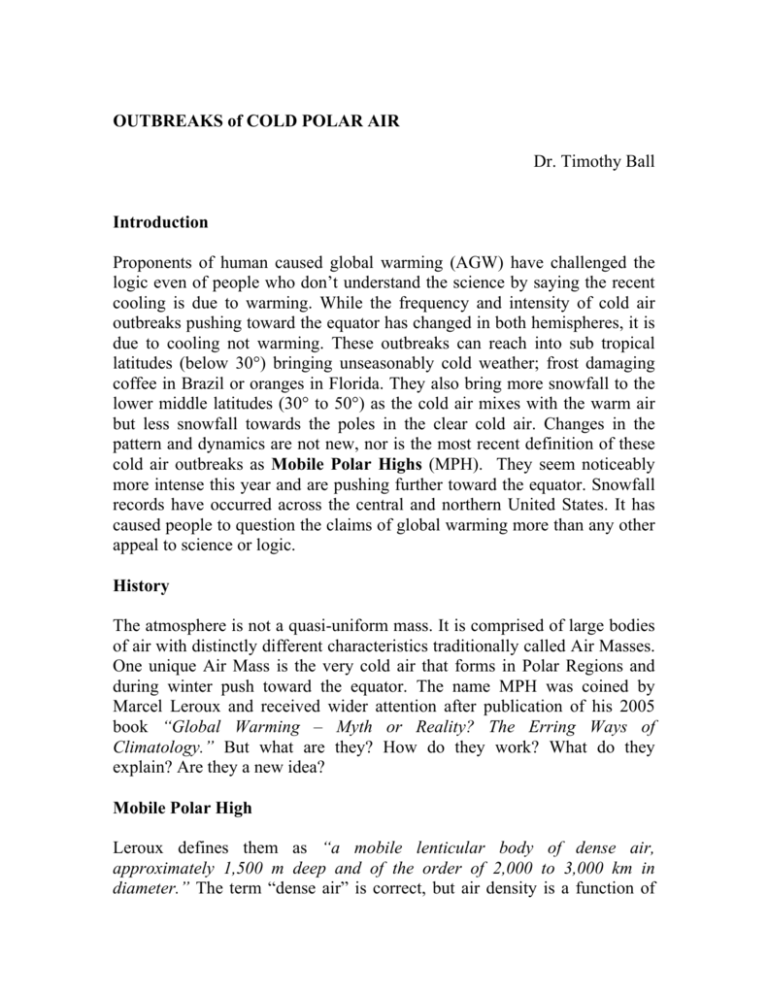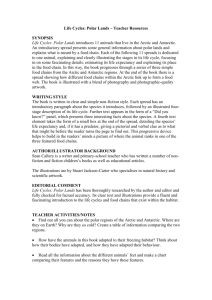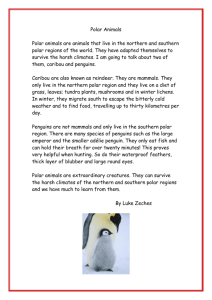OUTBREAKS of COLD POLAR AIR Dr. Timothy Ball Introduction
advertisement

OUTBREAKS of COLD POLAR AIR Dr. Timothy Ball Introduction Proponents of human caused global warming (AGW) have challenged the logic even of people who don’t understand the science by saying the recent cooling is due to warming. While the frequency and intensity of cold air outbreaks pushing toward the equator has changed in both hemispheres, it is due to cooling not warming. These outbreaks can reach into sub tropical latitudes (below 30°) bringing unseasonably cold weather; frost damaging coffee in Brazil or oranges in Florida. They also bring more snowfall to the lower middle latitudes (30° to 50°) as the cold air mixes with the warm air but less snowfall towards the poles in the clear cold air. Changes in the pattern and dynamics are not new, nor is the most recent definition of these cold air outbreaks as Mobile Polar Highs (MPH). They seem noticeably more intense this year and are pushing further toward the equator. Snowfall records have occurred across the central and northern United States. It has caused people to question the claims of global warming more than any other appeal to science or logic. History The atmosphere is not a quasi-uniform mass. It is comprised of large bodies of air with distinctly different characteristics traditionally called Air Masses. One unique Air Mass is the very cold air that forms in Polar Regions and during winter push toward the equator. The name MPH was coined by Marcel Leroux and received wider attention after publication of his 2005 book “Global Warming – Myth or Reality? The Erring Ways of Climatology.” But what are they? How do they work? What do they explain? Are they a new idea? Mobile Polar High Leroux defines them as “a mobile lenticular body of dense air, approximately 1,500 m deep and of the order of 2,000 to 3,000 km in diameter.” The term “dense air” is correct, but air density is a function of temperature so it also means very cold air. MPH are large disc shaped parcels of cold air that move out of the polar regions carrying extremely cold conditions to lower latitudes. Here is the diagram he provides; Source: M. Leroux, 2005, p.155. The diagram is unclear, especially if you are not familiar with weather maps and cross-sections through the atmosphere. Imagine the stippled area in both diagrams as a shallow dome of very cold air advancing from top left to bottom right. Map (a) “Surface” is looking down on two pressure cells, the MPH (stippled area) is an area of very high pressure with clockwise rotation of air. A Lowpressure cell marked “D” with counterclockwise circulation is shown to the northeast of the MPH. Notice also the small “d” area around the MPH, which indicate regions of low pressure. The entire system in this case is shown moving to the southeast. The wind circulation and direction of movement indicate this is in the Northern Hemisphere. The Cross-section (b) “Zonal section” is effectively along the line of the large arrow showing direction of movement. Again the stippled area is the actual cold dense air of the MPH. Notice the leading edge of the advancing cold air on the right is a bull–nosed shape indicating a steep cold front. This pushes the warmer air up creating extreme instability that results in the formation of severe thunderstorms as depicted. On the right side it shows the cold air pushing out, but now you have to add in the movement of the entire system so the slope of the front is much shallower. Technically it is questionable whether vertical development clouds (cumulus) would occur along what is effectively a warm front. Actually, what happens is the warm air runs in behind and up over the retreating cold air. Notice that there are no clouds over the major part of the high-pressure dome. Descending air over the High Pressure creates the clear skies associated with these systems. Air has conservative properties and so an Air Mass retains its characteristics for a considerable time. It is modified first in the air in contact with the ground; however, this requires it be considerably different. If, as often occurs in winter, the underlying surface of snow or frozen ground means it remains very cold for many days. Leroux says, “The first time that the necessity for a new conception of general circulation came to me was during research into tropical meteorology.” This is not surprising because as I wrote in my article on the tropopause, attempts to formulate the tropical circulation were resolved at the beginning of the 18th century while knowledge of middle latitude and polar circulations are still in flux. Air Masses Many people see the tropical circulation of the Hadley Cell as a major driving force for the atmosphere. The only link or relationship between the Hadley Cell and the Polar air is the difference in temperature between the equator and the poles. More important it is cold air that dictates the movement of air in the high and middle latitudes. As Leroux notes the MPH is dense air, which means that less dense warm air is always pushed out of the way of advancing cold air or moves in behind retreating cold air. When students turn in research papers I always looked at the bibliography first because with any topic the classic research should be listed. If it is not then the research is totally inadequate and the work possibly flawed. Sadly, this is the case with Leroux’s book. There is no mention of classic research on arctic and polar climates with names such as Reid Bryson or Kenneth Hare noticeably missing. Proper research discloses that a classification system and theoretical mechanism already exists. These domes of cold polar air migrating toward the equator are identified in the Air Mass typology as continental arctic air (cA). Air masses are identified by the place of origin and the characteristics of the air by temperature and moisture levels. Continental arctic air originates over land or ice at high latitude and is very cold dry air. There are two major classifications, continental and maritime, and secondary divisions of arctic polar and tropical. A combination of two factors such as maritime and polar was the source region of maritime polar identified as mP on a weather map. Air sits over a region and takes on the characteristics of the area and carries those with it when it moves. Table 1 shows the standard air masses and their characteristics. TABLE 1. Air Mass categories and Weather characteristics for North America. (Source; Oliver and Hidore, 1984, p.253.) The following diagram shows the types of air masses, their source and trajectories influencing North America. Source; Climatology, Oliver and Hidore, 1984, p. 252. A critical boundary determining the general weather pattern of the continent is not depicted, but inferred on the chart. Generally known as the Polar Front it separates arctic and polar air from the tropical air. The mean position of the Front is further toward the equator and has been moving that way in the Southern Hemisphere for 20 years and in the Northern Hemisphere for 8. As a result there are more outbreaks of more intense cold air, which are now called Mobile Polar Highs but are no different than the traditional continental arctic (cA) air masses. Conclusion What triggers the movement of these air masses? To my knowledge there was no adequate explanation, although clearly it was a combination of the rotation of the earth and the density of the air. Perhaps the only addition of Leroux’s work is a possible explanation that combines these factors. “The thermal deficit which is ever present at high latitudes, and at its greatest in winter, is responsible for the cooling and subsidence of the air above the Arctic/Greenland and Antarctica. As the descending air falls into step with the Earth’s rotation, it will reach a critical mass and detach itself, rather like a drop of water, moving away from the polls in the lower layers as a mobile lenticular body of dense air.” Better understanding of these systems and their mechanism is essential to forecasting weather conditions in the middle latitudes from approximately 30° to 65°. As cooling continues with declining solar activity the intensity and frequency of these outbreaks of intensely cold polar air will continue. Unfortunately, the excessive focus on global warming means this critical area is receiving little research attention. February 2009






